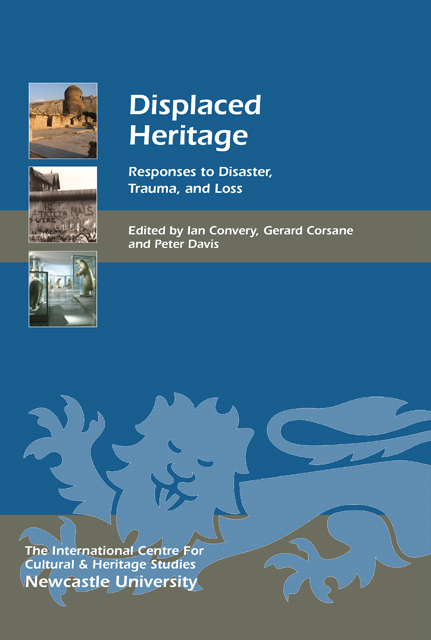Book contents
- Frontmatter
- Contents
- List of Illustrations
- Acknowledgments
- List of Abbreviations
- Preface
- Introduction
- Displaced Heritage: Histories and Tourism
- Displaced Heritage: Trauma, Confinement and Loss
- Displaced Heritage: Lived Realities, Local Experiences
- Displaced Natural Heritage
- Endpiece
- List of Contributors
- Index
- Heritage Matters
14 - Troubled ‘Homecoming’: Journey to a Foreign yet Familiar Land
Published online by Cambridge University Press: 24 February 2023
- Frontmatter
- Contents
- List of Illustrations
- Acknowledgments
- List of Abbreviations
- Preface
- Introduction
- Displaced Heritage: Histories and Tourism
- Displaced Heritage: Trauma, Confinement and Loss
- Displaced Heritage: Lived Realities, Local Experiences
- Displaced Natural Heritage
- Endpiece
- List of Contributors
- Index
- Heritage Matters
Summary
Introduction
In August 2011, my daughter Nicola and I travelled to Lithuania to commemorate the memory of my paternal grandparents, Mashe and Mordechai Mazel, and other family members who were murdered on Saturday 23 August 1941, and to say kaddish for them. On that day in 1941, the Nazis and their Lithuanian collaborators killed 7523 people in the Pajouste forest, around eight kilometres east of Panevėžys. Panevėžys experienced six recorded episodes of killing between 21 July and 23 August 1941 (Anon 2005, 145). Altogether, the Nazis and Lithuanians killed 8837 people in Panevėžys, 99% of whom were Jews (see Table 14.1; Levinson (ed) 2006, 146–8). When I planned the trip it was unknown to me that the Pajouste forest was also the death site for my maternal relatives from the village of Ramygala, some 30 kilometres south of Panevėžys. The Jews of Ramygala had in fact been removed to the Panevėžys ghetto in mid-July 1941 (Yahadut Lita vol 4, cited in Levinson (ed) 2006, 329–31). This realisation added additional poignancy to the visit. I have since learned, however, that my maternal great-grandmother, Sarah Nochemovitz, was likely to have died in Ramygala because the ‘elderly and sick were left in the Beit Midrash that was set on fire and they were burned alive’ (Rosin 1996).
As part of the journey we spent a few days in Vilnius, the capital of Lithuania, visiting museums and heritage centres, some of which focused on Jewish heritage. Visiting Lithuania, Panevėžys, Ramygala and Pajouste forest has stirred in me a series of emotional and academic responses about the Holocaust, its impact on my parents and my family, and the Lithuanian response to this fraught heritage. This short chapter explores various aspects of the visit in relation to public and private issues. Accordingly, it is both autobiographical and academic. Three issues are addressed: (i) the feeling of ‘homecoming’ that I experienced in Lithuania and especially Panevėžys, although it was my first visit; (ii) the emotions and thoughts that emerged during our walk down M Valančiaus Gatve, the street where my father grew up; and (iii) the representation of Jews in Vilnius’ museums.
Did I dare say it? In some ways I felt very much at home in this land of bears and forebears.
- Type
- Chapter
- Information
- Displaced HeritageResponses to Disaster, Trauma, and Loss, pp. 151 - 162Publisher: Boydell & BrewerPrint publication year: 2014



